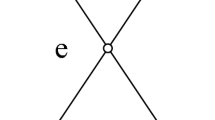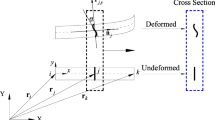Abstract
This paper comprehensively investigates the buckling load and the stability of a planar linear array deployable structure composed of scissor-like element (SLE) under compression. At present, the researches on deployable structure are mainly focused on configuration design and dynamics characteristics of the mechanisms, but less research on structural instability. In fact, when the external load exceeds the structural critical load value, the deployable structure will be permanently deformed or even collapse directly and no longer have any bearing capacity. To address this issue, a new stability model is derived using linear elastic analysis method and substructure method to evaluate the buckling characteristics of the deployable structure with n SLEs when it is carried out in space, which can accurately obtain the structural instability load and can be used quantitatively to optimize the structure for making it have the most stable configuration. In addition, the effects of the number of elements, the length, material properties and flexibility of the bar, and the deployment degree on the buckling of the scissor deployable structure are investigated, and the results of the theoretical analysis are compared with simulation and analytical results, respectively, confirming that the proposed stability model not only is able to effectively predict the structural instability load but also determine which part of the deployable structure is unstable. It can be concluded that the stability of the deployable structure gradually decreases with the increase of the number of elements or the bar flexibility. In the calculation process, the critical load of each sub-element should be considered, and the minimum value of the critical loads of all subunits can be regarded as the instability load of the whole structure.
Similar content being viewed by others
References
Hachem C, Karni E, Hanaor A. Evaluation of biological deployable systems. Int J Space Struct, 2005, 20: 189–200
Hachem C, Karni E, Hanaor A. Deployable structures in nature: Examples, analysis and realization. J Inter Assoc Shell Spat Struct, 2004, 45: 190–198
Lederman G, You Z, Glišić B. A novel deployable tied arch bridge. Eng Struct, 2014, 70: 1–10
Gantes C, Giakoumakis A, Vousvounis P. Symbolic manipulation as a tool for design of deployable domes. Comput Struct, 1997, 64: 865–878
Floreano D, Wood R J. Science, technology and the future of small autonomous drones. Nature, 2015, 521: 460–466
Di Luca M, Mintchev S, Heitz G, et al. Bioinspired morphing wings for extended flight envelope and roll control of small drones. Interface Focus, 2017, 7: 20160092
Li T J. Deployment analysis and control of deployable space antenna. Aerosp Sci Tech, 2012, 18: 42–47
Ma J, Song J, Chen Y. An origami-inspired structure with graded stiffness. Int J Mech Sci, 2018, 136: 134–142
Chen W J, Luo Y Z, Fu G Y, et al. A study on space masts based on octahedral truss family. Int J Space Struct, 2001, 16: 75–82
Peng Q, Wang S, Li B, et al. A novel thermo-flexible coupled dynamics analysis method of planar deployable structures in the deploying process. P I Mech Eng C-J Mec, 2019, 233: 6089–6098
Chen Y, Peng R, You Z. Origami of thick panels. Science, 2015, 349: 396–400
You Z, Pellegrino S. Cable-stiffened pantographic deployable structures. I—Triangular mast. AIAA J, 1996, 34: 813–820
Sarrus P T. Note sur la transformation des mouvements rectilignes alternatifs, en mouvements circulaires, et reciproquement. Comptes Rendus Hebdomadaires des Séances de l’Académie des Sciences, 1853, 36: 1036–1038
Bricard R. Mémoire sur la théorie de l’octaèdre articulé. J Math Pure Appl, 1897: 113–148
Bennett G T. Deformabl octahedra. Proc London Math Soc, 1912, 10: 309–343
Baker J E. The Bennett, Goldberg and Myard linkages—In perspective. Mech Mach Theory, 1979, 14: 239–253
Kebadze E, Guest S D, Pellegrino S. Bistable prestressed shell structures. Int J Solids Struct, 2004, 41: 2801–2820
Chen Y, You Z, Tarnai T. Threefold-symmetric Bricard linkages for deployable structures. Int J Solids Struct, 2005, 42: 2287–2301
Zhao J S, Chu F, Feng Z J. The mechanism theory and application of deployable structures based on SLE. Mech Mach Theory, 2009, 44: 324–335
Guest S D, Pellegrino S. Analytical models for bistable cylindrical shells. Proc R Soc A, 2006, 462: 839–854
Gantes C, Connor J J, Logcher R D. A systematic design methodology for deployable structures. Int J Space Struct, 1994, 9: 67–86
Akgün Y, Gantes C J, Sobek W, et al. A novel adaptive spatial scissor-hinge structural mechanism for convertible roofs. Eng Struct, 2011, 33: 1365–1376
Zhang Y Q, Yang D W, Sun Z H, et al. Winding strategy of driving cable based on dynamic analysis of deployment for deployable antennas. J Mech Sci Technol, 2019, 33: 5147–5156
Santo L, Bellisario D, Iorio L, et al. Shape memory composite structures for self-deployable solar sails. Astrodynamics, 2019, 3: 247–255
Tang Y Q, Li T J, Liu Y, et al. Minimization of cable-net reflector shape error by machine learning. J Spacecraft Rockets, 2019, 56: 1–8
Hu H Y, Tian Q, Zhang W, et al. Nonlinear dynamics and control of large deployable space structures composed of trusses and meshed. Adv Mech, 2013, 43: 390–414
Zhang Y, Duan B Y, Li T J. Integrated design of deployment trajectory and control system for deployable space antennas. Chin J Mech Eng-En, 2011, 47: 21–29
Ma X F, Li T J. Dynamic analysis of uncertain structures using an interval-wave approach. Int J Appl Mech, 2018, 10: 1850021
Li B, Wang S M, Makis V, et al. Dynamic characteristics of planar linear array deployable structure based on scissor-like element with differently located revolute clearance joints. P I Mech Eng C-J Mec, 2018, 232: 1759–1777
Yan S, Shen Y, Chen H. Dynamic performance of deployable structures with flexible members and clearance connections. J Tsinghua Univ, 2003, 43: 145–148
Li B, Wang S M, Yuan R, et al. Dynamic characteristics of planar linear array deployable structure based on scissor-like element with joint clearance using a new mixed contact force model. P I Mech Eng C-J Mec, 2016, 230: 3161–3174
Chen X L, Jia Y H. Wear analysis of spatial parallel mechanisms with multiple three-dimensional spherical clearance joints. J Tribol, 2019, 141: 101604
Yan S, Xiang W, Zhang L. A comprehensive model for 3D revolute joints with clearances in mechanical systems. Nonlinear Dyn, 2015, 80: 309–328
Peng Q A, Wang S M, Zhi C J, et al. A new flexible multibody dynamics analysis methodology of deployable structures with scissor-like elements. Chin J Mech Eng, 2019, 32: 77
Erkaya S, Doğan S, Ulus Ş. Effects of joint clearance on the dynamics of a partly compliant mechanism: Numerical and experimental studies. Mech Mach Theory, 2015, 88: 125–140
Flores P, Koshy C S, Lankarani H M, et al. Numerical and experimental investigation on multibody systems with revolute clearance joints. Nonlinear Dyn, 2011, 65: 383–398
Li B, Wang S M, Zhi C J, et al. Analytical and numerical study of the buckling of planar linear array deployable structures based on scissor-like element under its own weight. Mech Syst Signal Pr, 2017, 83: 474–488
Lessinnes T, Goriely A. Design and stability of a family of deployable structures. Siam J Appl Math, 2016, 76: 1920–1941
Wang W, Rodrigue H, Ahn S H. Deployable soft composite structures. Sci Rep, 2016, 6: 20869
Gantes C J. Overview of scissor-type, bi-stable deployable structures. In: Proceedings of IASS Annual Symposia, IASS 2018 Boston Symposium: Transformables. 2018. 1–8
Gantes C J. Design strategies for controlling structural instabilities. Int J Space Struct, 2000, 15: 167–188
Hilburger M. Developing the next generation shell buckling design factors and technologies. In: 53rd AIAA/ASME/ASCE/AHS/ASC Structures, Structural Dynamics and Materials Conference, 20th AIAA/ASME/AHS Adaptive Structures Conference. Honolulu, 2012. 1686
Degenhardt R, Castro S G P, Arbelo M A, et al. Future structural stability design for composite space and airframe structures. Thin-Walled Struct, 2014, 81: 29–38
Raskin I, Roorda J. Nonlinear analysis of uniform pantographic columns in compression. J Eng Mech, 1999, 125: 1344–1348
Gantes C J, Konitopoulou E. Geometric design of arbitrarily curved bi-stable deployable arches with discrete joint size. Int J Solids Struct, 2004, 41: 5517–5540
Avilés R, Goizalde Ajuria M B, Victoria Hormaza M, et al. A procedure based on finite elements for the solution of nonlinear problems in the kinematic analysis of mechanisms. Finite Elem Anal Des, 1996, 22: 305–327
Gillman A, Fuchi K, Buskohl P R. Truss-based nonlinear mechanical analysis for origami structures exhibiting bifurcation and limit point instabilities. Int J Solids Struct, 2018, 147: 80–93
Raskin I. Stiffness and stability of deployable pantographic columns. Dissertation for Doctoral Degree. Waterloo: University of Waterloo, 2000. 20–76
Author information
Authors and Affiliations
Corresponding authors
Rights and permissions
About this article
Cite this article
Li, B., Wang, S. & Tan, UX. Buckling analysis of planar linear uniform deployable structures consisting of scissor-like element in space under compression. Sci. China Technol. Sci. 64, 493–507 (2021). https://doi.org/10.1007/s11431-020-1569-6
Received:
Accepted:
Published:
Issue Date:
DOI: https://doi.org/10.1007/s11431-020-1569-6




